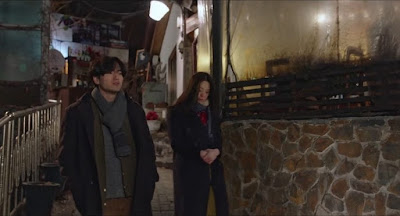A blog from me, Jeffrey Wang, about Asian film and culture, as well as discussions of films from throughout the world. I am an Asian-American filmmaker and writer. Please check out my books for sale at Amazon at this link: CLICK HERE
Monday, March 2, 2020
FILM REVIEW: A TIGER IN WINTER
A Tiger in Winter (2017) is a beguiling and incisive portrait of the artistic process of writing. The practice of writing is a solitary and not exactly cinematically dynamic process, but with A Tiger in Winter, Lee Kwang-kuk is able to really get at the essence of the struggling artist. Lee is not necessarily concerned with the actual ritual of writing, but with the writer’s inability to fit into society and function as others do. By focusing on the dysfunctional life of an artist, A Tiger in Winter offers an often bitterly funny view of the creative life.
Lee Kwang-kuk was formerly an assistant director for the celebrated Korean filmmaker Hong Sang-soo. Indeed, Hong Sang-soo’s influence is strongly felt in A Tiger in Winter, with its long, seemingly improvised scenes of uninterrupted dialogue, and its focus on male/female relationships. Like the films of Hong Sang-soo, A Tiger in Winter is about a man who is unable to commit to the women in his life.
The protagonist of A Tiger in Winter is Gyeong-yu (Lee Jin-wook), a struggling writer who leaves his girlfriend and proceeds to wander around aimlessly until he meets his ex-girlfriend Yoo-jung (Go Hyun-jung). Unlike Gyeong-yu, Yoo-jung is a celebrated writer, but her chronic alcoholism prevents her from meeting her publisher’s deadline to complete her next collection of short stories. A Tiger in Winter is about Gyeong-yu and Yoo-jung’s attempts to reconcile their former relationship, while both of them struggle to fulfill their personal and artistic needs.
While the influence of Hong Sang-soo is felt throughout A Tiger in Winter, Lee Kwang-kuk is also a much more visually poetic director than Hong. While Hong is primarily interested in using cinema to explore the relationships dynamics between women and men, Lee’s aesthetic concerns are more oriented towards the visual palette and symbolism. The title of the film itself refers to an actual tiger that has escaped from the zoo, and this tiger is symbolically portrayed by the two main protagonists. Like tigers who are away from captivity, both Yoo-jung and Gyeong-yu are self-destructive forces of nature that devour all those around them.
Yoo-jung is constantly taking advantage of those closest to her, including Gyeong-yu, to fulfill her needs, whether they be her physical needs (through her addiction to sex and alcohol), as well as her needs to be recognized as a celebrated author. Gyeong-yu also manipulates his friends and loved ones to fulfill his selfish desires to remain constantly aloof from commitment; he does so because he believes it will benefit his artistic process as a writer. Throughout the film, Lee explores how his two protagonists destroy those closest to them, like wild tigers escaped from captivity. Near the end of the film, Lee also reveals what appears to be imaginary glimpses of the actual escaped tiger, adding an element of visual surrealism to his mise-en-scene.
There are many delightfully odd moments in A Tiger in Winter, such as when Yoo-jung drunkenly peels some tangerines and places them in a haphazard pile on a table, without eating them, or when Gyeong-yu keeps meeting passengers on his driving route who refuse to pay him. These little moments reveal the eccentric nature of artists, which is what A Tiger in Winter is ultimately about. Lee wants to show us the private, interior lives of real artists, both those who struggle to be discovered, and those whose fame and career may be built upon dubious means. It will be interesting to see how Lee further develops his talents as an artist himself, and we are all captive spectators to his intriguing work.
Subscribe to:
Post Comments (Atom)





No comments:
Post a Comment